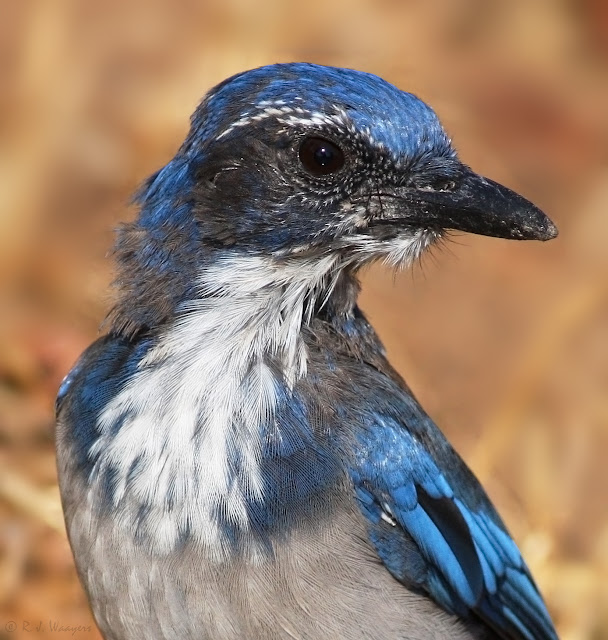What formerly was known as the Western Scrub Jay has since been split into two species, the California Scrub Jay and Woodhouse's Scrub Jay. The California Scrub Jay resides here in the western portion of the former range of the Western Scrub Jay, so it is the jay I see on my property here in the Cuyamaca Mountains. It has a darker, richer blue color than the interior western Woodhouse's Jay.
I've been photographing the jays from the blind I set up periodically. Their patterns seem fairly consistent throughout the year, with the appearance of juveniles in the summertime.
Here are some photographs with comments of various jays seen between February, 2018 and January 2019.
 |
| One of the first images from the blind, facing east on a cloudy day. |
 |
| Portrait, April 2018 |
 |
| A juvenile, August 2018. Mostly gray where blue will appear later in the adult plumage. Some pink at the corner of the mouth indicates its youthfulness also. This one looks a little disheveled overall, too! |
 |
| Portrait of a youngster, August 2018 |
 |
| I kept seeing what looked like a jay with a skull for a head in the trail cam images from the property! Eventually this bird appeared when I was in the blind and I could get detailed images of it. The scabbiness suggests disease rather than a simultaneous head-feather-molt, which jays sometimes experience. |
 |
| A grainy crop from the trail cam, August 2018. This bird hung around the area for a couple weeks and then seemed to disappear. It was typically on its own when a group of jays was present. |
 |
| Portrait, late August 2018 |
 |
| I wonder if this bird is older? It's bill seems more rounded than the bird in the previous portrait, and than most of the birds photographed. Wear and tear with age? August 2018. |
 |
| The blunt-billed bird, ready for take-off, with nictitating membrane deployed. August 2018. |
 |
| Young bird, September 2018 |
 |
| November 2018 |
 |
| November 2018 |
 |
| January 1st, 2019, after the New Year's Eve snow (only about an inch). |
 |
| New Year's Day, 2019 (note the drop of water on the bill from the damp post-snow conditions). |
 |
| On one of the small re-sprouted oaks, late January 2019. |
 |
| One of my favorite shots to date, on what will hopefully become a "hummingbird perch". Late January 2019. |




























